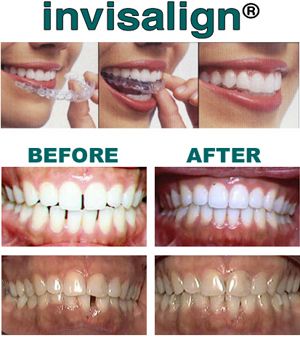How Much Does Invisalign Cost?
Last Updated on April 4, 2024
Written by CPA Alec Pow | Content Reviewed by ![]() CFA Alexander Popinker
CFA Alexander Popinker
With its nearly invisible, removable clear aligner trays, Invisalign has surged in popularity as an alternative to traditional metal braces for straightening teeth. Especially appealing to teens and adults, Invisalign offers improved aesthetics and comfort compared to fixed braces. But this high-tech orthodontic treatment comes at a cost. So how much does Invisalign actually cost on average?
In this article, we’ll delve into the myriad pricing factors that influence Invisalign costs, including the extent of dental correction needed, treatment length, your orthodontist’s fee structure, and considerations like insurance coverage.
Understanding Invisalign pricing dynamics allows you to budget and set expectations accurately before starting your smile transformation journey. Whether you’re considering Invisalign for yourself or your family, use this advice to demystify the costs involved.
How Much Does Invisalign Cost?
The minimum cost for Invisalign treatment typically ranges from $3,000 to $5,000 for more straightforward cases requiring fewer aligner sets, while complex treatments requiring extensive movements can cost above $8,000. Orthodontist fees, which vary based on factors like experience and location, can add additional costs to the overall expense of Invisalign treatment.
Invisalign costs can vary widely based on these main elements:
Severity of Corrective Treatment Needed
How extensive the required tooth movements are directly correlates to how many custom aligner trays will be needed over the full course of treatment, which is a primary cost driver.
- Minor to moderate alignment cases typically call for 12-48 aligners over 6-18 months of treatment.
- More complex treatments involving substantial tooth rotation or repositioning need 36-60 aligners and span closer to 18-24 months.
- Extreme corrections with extractions or surgery may need 80+ aligner sets over 2+ years of treatment time.
In general, the more aligner sets required, the higher the total Invisalign case cost.
Total Duration of Treatment
The estimated overall length of treatment time also affects the overall expense:
- More straightforward cases requiring just 1-2 aligner sets per month could cost $3,000-$5,000 in total.
- Moderate treatments lasting 12-18 months often range from $5,000-$8,000 with more aligners needed.
- Complex cases requiring 2+ years of aligners due to extensive movements generally cost above $8,000.
Orthodontist Fees
Orthodontists set their own Invisalign fees based on factors like years of experience, office overhead, and local cost of living. Premier Invisalign providers or those based in major metro areas tend to price at the higher end of the range.
Some orthodontist fee ranges:
- Initial records & consultation – $200-$500
- Aligner set fee – $100-$300 per set
- Retainer fee – $300-$500
Dental Insurance Coverage
Some dental insurance plans cover a portion of orthodontic treatment like Invisalign, which can significantly offset out-of-pocket expenses. But many plans impose:
- Annual or lifetime benefit maximums – Capping coverage at $1,000-$3,000 total
- Coinsurance percentages – Covering only 50% of orthodontic treatment costs
- Waiting periods – Requiring 1 year+ before orthodontic benefits activate
Medicaid coverage for Invisalign varies by state. Traditional Medicare does not include routine orthodontic coverage, but Medicare Advantage plans sometimes do.
Forbes Health mentions that more severe cases of Invisalign treatment can cost from $4,500 to $8,000, with prices varying based on the treatment package required.
Sandy Smiles Orthodontics discusses the average cost of Invisalign treatment, indicating a range from $2,700 with insurance to as much as $7,595 without insurance.
Healthline offers insights into the cost of Invisalign treatment, mentioning estimates from the Invisalign website ranging from $3,000 to $7,000.
The Invisalign website provides information on the cost of treatment, stating that the average cost ranges from $3,000 to $7,000. They also highlight the possibility of insurance coverage up to $3,000 and offer various payment options, including Health Savings Accounts (HSA) and Flexible Spending Accounts (FSA).
What is Invisalign Treatment?
Unlike fixed metal wire braces that are cemented on, Invisalign utilizes a series of custom-fabricated, clear plastic aligners that incrementally move the teeth into proper position over months of treatment.
Each Invisalign aligner tray is worn for roughly 2 weeks before switching to the next aligner in the treatment series, gradually shifting the teeth. Most patients require somewhere between 12 and 48 aligner sets, though more may be needed for complex cases.
Benefits of Invisalign over traditional braces include:
- More aesthetic look, with clear aligners being barely noticeable
- Ability to remove aligners for eating, drinking, cleaning and special occasions
- Less irritation and discomfort compared to metal braces
- Shorter treatment timeframes in many cases
- Improved ability to maintain oral hygiene
While not inexpensive, for many the Invisalign system is well worth the investment for a confident, healthy smile.
What Impacts Invisalign Pricing?
Several factors influence the total price quoted for Invisalign treatment.
Case Complexity and Required Movement
The complexity of the initial malocclusion and the amount of movement required correlates to how many aligners will be needed. Simpler cases need fewer aligner trays over a shorter overall treatment duration.
- Closing minor gaps without extensive rotation may need just 10-15 trays over 4-6 months.
- Crowding requiring pushing back protruding teeth may need 15-25 trays over 6-12 months.
- Spacing issues with moderate rotation could need 20-40 trays over 12-18 months.
- Severe issues like crossbites or jaw misalignment may need 40-60+ trays over 18-24+ months.
In general, the more extensive the orthodontic correction required, the greater the number of aligners, length of treatment, and overall cost.
Treatment Duration
Cases requiring only 4-6 months of aligners due to easier movements cost substantially less than slower treatments spanning 18+ months. Limiting the number of trays needed lowers costs.
Choice of Orthodontist
Experienced Invisalign providers charge higher fees but may achieve better, quicker outcomes. Where the practice is located also impacts pricing, as discussed next.
Location and Regional Factors
Invisalign costs more in major metropolitan areas where rents and labor overhead are higher. Suburban and rural orthodontists often price lower.
But no matter where you live, be sure to weigh orthodontist experience and treatment approach, not just base cost.
You might also like our articles about the cost of teeth gap fixing, retainers, or braces.
Itemized Pricing Breakdown
Contributing costs that are typically included in an Invisalign treatment quote include:
Records and Initial Consultation
- Orthodontic records like X-rays, 3D scans, photos – $200-$500
- Clinical exam to evaluate current alignment issues – $0-$200
- Discussion of treatment options and Invisalign specifics – $0-$300 consultation fee
Invisalign Aligners
- Ordering the custom-fabricated clear aligner trays – $1,000-$5,000
- Impression molds or 3D scans to design aligners – $0-$500
- Virtual treatment simulation preview – $0-$300
Supplemental Aligner Elements
- Attachments bonded onto certain teeth to direct movements – $50-$300 per tooth
- Compliance indicators – Clear bumps on aligners to track wear time – $0-$100
Retainers After Treatment
- Vivera clear retainer for maintaining results – $300-$500 for 4 sets
- Bonded fixed wire retainer behind lower front teeth – $250-$350 per arch
Regular Orthodontist Check-Ins
- Appointments every 4-8 weeks to monitor progress – $0-$200 per visit
- Any needed aligner adjustments or issues addressed – hourly orthodontist rate
Potential Supplementary Dental Work
- Tooth extractions or dental bonding prior to Invisalign – $100-$300 per tooth
- Reshaping teeth after treatment – $50-$150 per tooth
Office Administrative Fees
- Costs like records storage, bill processing – $100-$500
- Digital treatment monitoring – $0-$300
Insurance Coverage and Payment Plans
 Many dental insurance plans provide some orthodontic coverage that can partially offset Invisalign costs through:
Many dental insurance plans provide some orthodontic coverage that can partially offset Invisalign costs through:
- Coinsurance – Plans covering 50% of treatment costs on average
- Lifetime maximums – Capping coverage at $1,000-$3,000 total per person
- Wait periods – Requiring active enrollment for 1 year before orthodontic benefits apply
But potential limitations exist:
- No orthodontic coverage – Around 30% of dental plans
- Excessive copays or deductibles – Causing high out-of-pocket costs
- Low lifetime maximums – Providing inadequate benefit amounts long-term
Thoroughly review your plan details to understand coverage, limitations, required cost-sharing, and pre-approvals needed.
For uninsured patients, many orthodontists offer no-interest payment plans to spread costs over months or years. The orthodontist covers treatment costs upfront and accepts monthly patient payments.
Using tax-advantaged FSA and HSA accounts to pay orthodontic expenses is another smart savings strategy.
How Does Invisalign Stack Up on Cost?
Vs. Traditional Metal Braces
Braces often cost $5,000-$6,000 on average, including adjustments. While metal braces have a lower upfront expense, Invisalign offers a shorter treatment time and aesthetic benefits.
Vs. Other Clear Aligners
Alternatives like ClearCorrect can cost 20-40% less but lack the brand recognition of market leader Invisalign. Shop around for options and compare orthodontist experience with each brand.
Tips for Budgeting for Invisalign Treatment
- Get quotes from multiple qualified orthodontists in your area for cost comparison
- Thoroughly review dental plan coverage and maximize benefits used
- Take advantage of tax-free funding via FSA, HSA, IRA accounts if possible
- Inquire about possible payment plans, discounts for upfront payment, or insurance financing partnerships
- Consider only doing upper or lower arch first if full treatment unaffordable for now
- Have teens start when young to make use of parents’ dental coverage before ageing out
Final Words
Invisalign costs range widely but expect to budget $3,000 to $8,000 on average for comprehensive treatment. However, your case specifics, choice of orthodontist, insurance coverage, location, and treatment complexity can influence your final price.
Some payment assistance like dental insurance and payment plans can offset expenses. But confirm specifics in advance. Thoroughly discuss cost concerns and affordable options with your orthodontist when choosing the ideal treatment path to your desired smile.
Frequently Asked Questions
Is Invisalign worth the money?
For many patients, Invisalign is well worth the investment to achieve a healthier, more beautiful smile. While not cheap, when payments are financed over time, many find the boost to confidence and convenience compared to braces makes the expense manageable and worthwhile. Thoroughly discuss costs and financing with your orthodontist.
What are the cons of Invisalign treatment?
Potential cons include higher upfront cost than braces, the need for discipline wearing aligners as directed for proper results, difficulty eating with aligners in, potential for temporary speech impediment, and aesthetic limitations correcting extreme cases versus braces. Discuss the downsides with your orthodontist.
What is the Invisalign 22 hour rule?
Invisalign patients are instructed to wear the aligners for 20-22 hours per day to achieve expected results. The rest of the time they can be removed for eating, drinking, brushing, and special occasions. Following the prescribed wear time is key to effective treatment.
What shouldn’t you do while wearing Invisalign aligners?
Avoid very hot, crunchy, sticky, hard, or chewy foods and beverages that could damage the aligners. Brush carefully after eating before reinserting aligners. Take aligners out for contact sports or activities that may dislodge them. Don’t use harsh cleaning products that may degrade aligner material over time.


Leave a Reply
Want to join the discussion?Feel free to contribute!